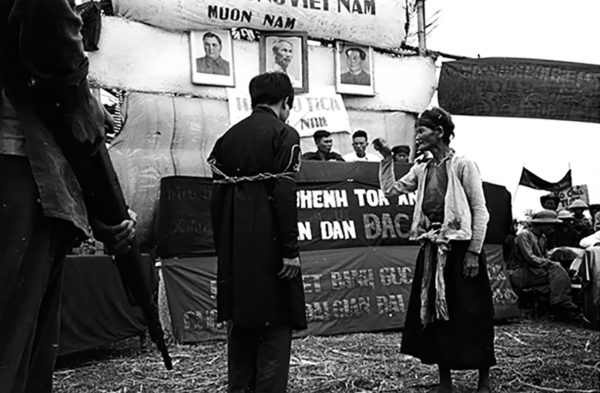
Dmitri Baltermants, Trial of a Bourgeois Landowner, Vietnam, 1955, Gelatin silver print (printed 2003), Gift of Sally Strauss and Andrew E. Tomback, Scripps College, Claremont, CA
Born in Warsaw, Poland in 1912, Dmitri Baltermants spent his early childhood amidst the civic unrest and political instability that characterized the First World War, which forced his family to leave Poland and migrate to Moscow when he was only two years old. After leaving secondary school to earn a living, Baltermants took on a variety of jobs such as metal grinder and cinema mechanic. However, it was at the Izvestia Printing House, where Baltermants was an apprentice printer, that he grew passionate about photography. With the advent of the Second World War came the beginning of Baltermants’ career as a combat photographer; he traveled across the Soviet Union photographing the war. Afterwards, Baltermants transitioned into photojournalism, working at a war correspondent for the illustrated magazine Ogonyok. During his time at Ogonyok, and up until his death, Baltermants traveled internationally, photographing world leaders such as Fidel Castro and Mao Tse-Tung. Despite living and working in the Soviet Union, Baltermants’ images exposed the grim realities of war and politics rather than focusing solely on nationalistic heroic imagery.
In his photograph, Trial of a Bourgeois Landowner, Vietnam, 1955, Baltermants captures the back of a standing figure whose arms and chest are shackled. The viewer is left to question the figure’s expression as a woman across from him, carrying a child, looks at him with condemnation. Is the bourgeois landowner to blame for the woman’s anger? Plastered around both figures are political signs suggesting that this is a “Special Court,” alongside images of Ho Chi Minh, Vietnam’s Communist leader; Georgy Malenkov, the leader of the Soviet Union; and Mao Tse-Tung, a leading figure in the Red China revolution. As viewers, we ask ourselves: can Communism heal her anguish?
Based on the title and content of the imagery, it becomes evident that the “Special Court” is punishing, and possibly executing, the shackled man under the premise of Communism. We can but suspect that the female figure is reprimanding the landowner for his accumulation of wealth and land. However, as we look at the image, it becomes evident that the “Special Court” and its shabby exterior lack an aura of legitimacy and authority.
During 1955, the time at which this photograph was taken, Vietnam had already undergone an extensive history of outside political rule. For almost 10 centuries, beginning in 111 BCE, Vietnam was under Chinese rule as the nation’s southern-most point and a part of the Han Empire. In the early 17th century, however, French missionaries began entering Vietnam in an effort to spread Christianity. Following a victory over China in 1884, France formed French Indochina, an assemblage of French colonial territories, which included Vietnam. Although nationalistic ideas sprouted under Chinese and French rule, uprisings and rebellions were largely unsuccessful—enabling France to control Vietnam up until 1945. In addition to French colonial rule, beginning in 1940 and up until 1945, Vietnam was “co-controlled” by Japanese forces who seized Vietnamese roads, ports, and railways.
The frustrations of existing under dual imperialism combined with a weakening Japanese front enabled the Nationalist and Communist leader Ho Chi Minh to found the Việt Minh—a national independence coalition—and seize control of Japanese-occupied territories. After ousting the Japanese, the question of who would rule Vietnam emerged. Therefore, later that year, during the Geneva Convention, representatives from leading countries such as the Soviet Union, France, and the United States decreed that Vietnam would be divided into two parts—a communist North Vietnam which was governed by Ho Chi Minh and a non-communist South Vietnam—pending an election that would unify the country. For those living in North Vietnam, communism was strongly intertwined with nationalism, utilizing The Communist Manifesto as a pathway for Vietnamese liberation and independence. Describing the modern bourgeois society as one “that has sprouted from the ruins of feudal society… [and has only] established new classes, new conditions of oppression, new forms of struggle in place of the old ones,” the Manifesto was used as grounds to initiate executions, such as that of the landowner, in an attempt to disseminate communism.
Noor Tamari, Getty Marrow Conservation and Collections Summer Intern, 2019
Works Cited
Brigham, Robert K. “Battlefield Vietnam: A Brief History.” PBS, Public Broadcasting Service, www.pbs.org/battlefieldvietnam/history/.
“Dmitri Baltermants.” The J. Paul Getty Museum, J. Paul Getty Trust, www.getty.edu/art/collection/artists/1504/dmitri-baltermants-russian-1912-1990/.
“Dmitri Baltermants.” Nailya Alexander Gallery, Nailya Alexander Gallery, www.nailyaalexandergallery.com/russian-photography/dmitri-baltermants.
“History.” Vietnam History, Depauw University, 2007, academic.depauw.edu/mkfinney_web/teaching/Com227/culturalPortfolios/VIETNAM/VIETNAM/history.html.
“Ho Chi Minh (1890-1969).” BBC History, BBC, 2014, www.bbc.co.uk/history/historic_figures/ho_chi_minh.shtml.
Hostetler, Lisa. “Dmitrii Baltermants.” International Center of Photography, International Center of Photography, 2 Mar. 2016, www.icp.org/browse/archive/constituents/dmitrii-baltermants?all%2Fall%2Fall%2Fall%2F0.
Llewellyn, Jennifer, et al. “Japanese Occupation of Vietnam.” Vietnam War, Alpha History, 18 June 2018, alphahistory.com/vietnamwar/japanese-occupation-of-vietnam/.
Marx, Karl, and Friedrich Engels. The Communist Manifesto. Monthly Review Press, 1998.
Spector, Ronald H. “The Vietnam War and the Media.” Encyclopædia Britannica, Encyclopædia Britannica, Inc., 27 Apr. 2016, www.britannica.com/topic/The-Vietnam-War-and-the-media-2051426.
“Vietnamese History: A Chronological Outline.” Edited by John F. Whitmore, Asia for Educators, Columbia University, 2009, afe.easia.columbia.edu/timelines/vietnam_timeline.htm.
Wilson Center Digital Archive. “GENEVA CONFERENCE OF 1954.” Wilson Center Digital Archive, Woodrow Wilson International Center for Scholars, digitalarchive.wilsoncenter.org/collection/7/geneva-conference-of-1954.

